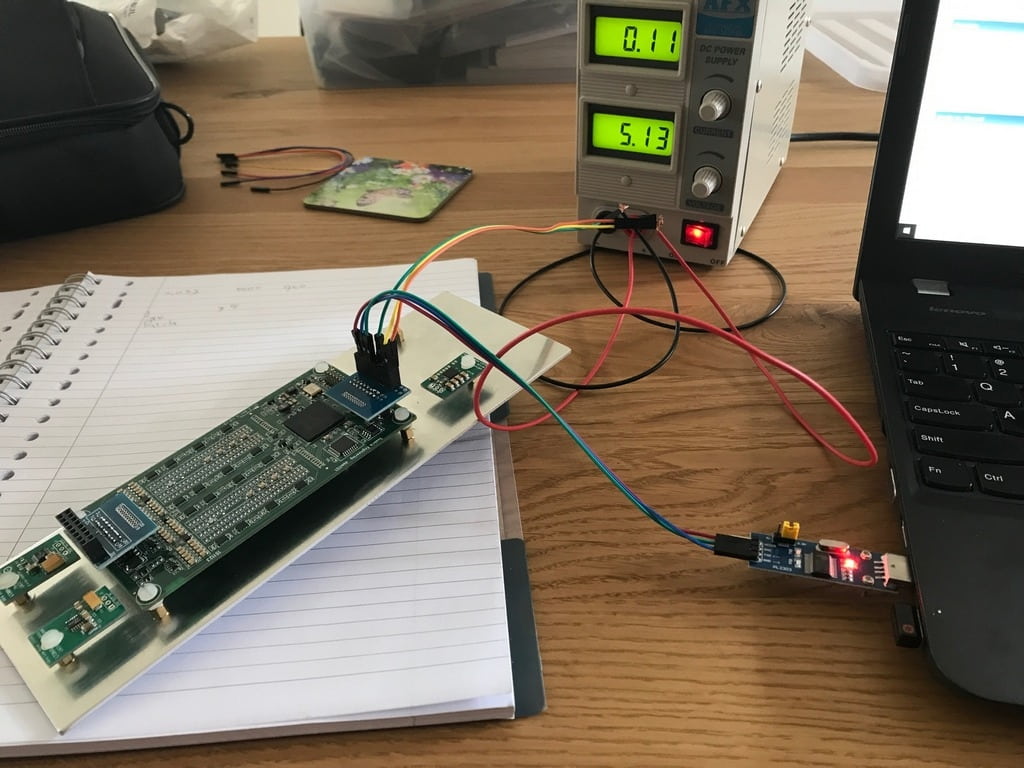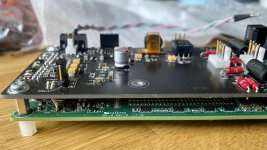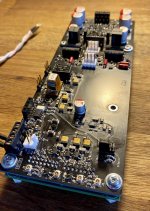Sören recently revealed that by use of a terminal and entering command +++, the clock adjustments are paused and we can listen to the DAC with a true re-clocker. Now, with such a small buffer, we can risk experience of pops ans clicks. I suggest that one leaves the DAC for a few minutes (15?) for the internal clock to adjust to the incoming in order to minimise the chance for such anomalies. To start the adjustements, just enter "exit" command. When I do this I often hear a small click which indicate that indeed, some timing/synchronisation event occur...
If you still hear a difference from a re-clocker in +++ mode connected over I2S or coaxial I think it would be ground dirt or radiated noise effecting the DAC. Use opto for optimal isolation?
//
If you still hear a difference from a re-clocker in +++ mode connected over I2S or coaxial I think it would be ground dirt or radiated noise effecting the DAC. Use opto for optimal isolation?
//
Last edited:
For me there was an audible difference with distorted guitars (rock, metal) and brass instruments (jazz). Sounded more natural to me.
Yes I read the +++ "hack" but haven't tried it since. It's not very convenient for me, because:
1) I don't always keep power on the dam and
2) the serial line needs rewiring away from my IsolatorPi and separate PSU back to the "dirty" RPi GPIO to work.
Ian's FifoPi plus recently released ReclockPi is probably state-of-the-art (plus I think you can still add Andrea Mori's Well Tempered Clock for true SOTA? I haven't investigated any further). I didn't go that route because it:
1) is more expensive than a Kali Relocker
2) requires 3.3V instead of 5V so for me another PSU, I tried the Kali first
3) is probably superfluous because the dam's clock performance is the bottleneck
Yes I read the +++ "hack" but haven't tried it since. It's not very convenient for me, because:
1) I don't always keep power on the dam and
2) the serial line needs rewiring away from my IsolatorPi and separate PSU back to the "dirty" RPi GPIO to work.
Ian's FifoPi plus recently released ReclockPi is probably state-of-the-art (plus I think you can still add Andrea Mori's Well Tempered Clock for true SOTA? I haven't investigated any further). I didn't go that route because it:
1) is more expensive than a Kali Relocker
2) requires 3.3V instead of 5V so for me another PSU, I tried the Kali first
3) is probably superfluous because the dam's clock performance is the bottleneck
I know but like I said I don't always keep my dam powered.
In any case I'd still recommend a reclocker in front of the dam -- no, not a reclocker per se, but a clock than has a 44.1 or 48 kHz multiple. The RPi doesn't have that so even you fix the dam's clock with +++ you will be getting an unevenly timed signal in.
And on an RPi that fix happens to be some reclocker.
In any case I'd still recommend a reclocker in front of the dam -- no, not a reclocker per se, but a clock than has a 44.1 or 48 kHz multiple. The RPi doesn't have that so even you fix the dam's clock with +++ you will be getting an unevenly timed signal in.
And on an RPi that fix happens to be some reclocker.
The clock out of a pi is rubbish. Will it even work in +++ mode without pops and clicks? But if it does, then you don't need any external reclocker. It just would not matter
//
//
Yes it does work without pops and clicks without an external reclocker. As for the audible merits an external reclocker still gives, well, I've said it a couple of times now and it's been said by others on the dam1021 thread as well.
So you mean that you hear a difference even when in +++ mode between with and without external reclocker? Which one sounds best to you?
//
//
I haven't tried at length, and it's not easy to A/B test because you have to rewire the I2S connection to try. I don't have a switch to put between.
Theoretically I see your point that it may not matter as long as there's a fixed clock -- be it the dam in +++ or some external source. In fact even the dam in +++ may be better because the otherwise tracking algorithm will by nature cause error in tracking the source clock. I never looked at it that way.
Theoretically I see your point that it may not matter as long as there's a fixed clock -- be it the dam in +++ or some external source. In fact even the dam in +++ may be better because the otherwise tracking algorithm will by nature cause error in tracking the source clock. I never looked at it that way.
I have argued that the DOLL in the DAM should isolate anything from outside impact. But I recently understood that the logic didn't work as it was initially described i.e. with a time constant of minutes. But in +++ mode the DAM internals has now lost all relation to any outside used clock but with the risk of blipps and plopps. But still, a galvanic connection could induce crap into the DAC.
//
//
My stack is RPi > IsolatorPi > Kali Reclocker > dam. The RPi has a separate PSU. Again theoretically 🙂 I could lock the dam in +++ and feed I2S from the IsolatorPi.
If only I could get that serial line working with separate so I could easily do it after power cycling, and without opening the lid...
so I could easily do it after power cycling, and without opening the lid...
The moment I put the entire stack on a single PSU (breaking galvanic isolation) the serial line works. So it must be a different GND voltage reference but really isn't that the point of serial? Maybe it's the case for RS232 / 485 but not for TTL.
If only I could get that serial line working with separate
 so I could easily do it after power cycling, and without opening the lid...
so I could easily do it after power cycling, and without opening the lid...The moment I put the entire stack on a single PSU (breaking galvanic isolation) the serial line works. So it must be a different GND voltage reference but really isn't that the point of serial? Maybe it's the case for RS232 / 485 but not for TTL.
Sorry cant help. The most isolated way one can hear a DAM i would suggest is one in +++ mode and fed by a couple of meter toslink with all radiating PSUs and the signal source some distance away. Remains the next component at the output that is galvanically connected and may, backwards induce dirt to the DAM or rock its earth.
//
//
Hi!
Has anybody done any improvements to the powering of the clock on 1121? How? Pictures?
//
yes, I done it many years ago.. and it looks like here in the attachment
Attachments
Is that whole board on the top a 3,3v source for the clock?
//
No, it is a board that contains many:
- separated power supplies for i2s, clock, spdif, digital 5v for 1121, analog 2x5v for 1121, buffer
- I2S input with reclocking
- aes/rca spdif
- buffer
Attachments
Hello guys!
I´m new here, and for my first project I´m building a dam 1121 as a DAC with a whammy headphone amp. So far so good, everything is working fine, so I´m begining the phase two where I will try to improve things a bit and fix some "temporary" things I´ve done while building it.
One thing that I can´t find a solution (I´m sure is very basic, what I´m going to ask) is how to plug things to the pins on the DAM 1121. I have some sockets "pitch 2.54" or something like that, but they are too big for the soekris board. I´ve ended up using some of these 2.54 plugs where I could, but they move around and it´s obvious that they are not meant for that use. Also the resistors and output cables I had to solder them directly because I had no room for anything else (I think it´s not ideal?? I don´t know...)
What is the name of these sockets for the board? Where can I find them? Or ... what´s the best way of plugging all the cables there in an "elegant" way?
I want to thank everybody on this thread, because there is enough info here to put to work a jlsounds usb input, with the soekris 1121 and all their respective power supplies just reading the whole thread. Even for someone who have done nothing similar to this before, like me.
Pablo
I´m new here, and for my first project I´m building a dam 1121 as a DAC with a whammy headphone amp. So far so good, everything is working fine, so I´m begining the phase two where I will try to improve things a bit and fix some "temporary" things I´ve done while building it.
One thing that I can´t find a solution (I´m sure is very basic, what I´m going to ask) is how to plug things to the pins on the DAM 1121. I have some sockets "pitch 2.54" or something like that, but they are too big for the soekris board. I´ve ended up using some of these 2.54 plugs where I could, but they move around and it´s obvious that they are not meant for that use. Also the resistors and output cables I had to solder them directly because I had no room for anything else (I think it´s not ideal?? I don´t know...)
What is the name of these sockets for the board? Where can I find them? Or ... what´s the best way of plugging all the cables there in an "elegant" way?
I want to thank everybody on this thread, because there is enough info here to put to work a jlsounds usb input, with the soekris 1121 and all their respective power supplies just reading the whole thread. Even for someone who have done nothing similar to this before, like me.
Pablo
Last edited:
Hi Pablo, the DAM1121 uses 2.00m pitch headers. I used 2.54 to 2.00 adapters which worked well, can't find them on the web now though sorry. Do some searching and you should find something suitable.
Pablo,
I use 2.0 (female) headers which I press on the Soekris male headers.
The female headers are meant for PCB mounting but I soldered my wiring directly to the solderpins of these headers.
First I tried with adapter PCB (2.0 tot 2.54 pitch) which was a bit wobbly and I did not like it.

Directly soldered to female header:

I use 2.0 (female) headers which I press on the Soekris male headers.
The female headers are meant for PCB mounting but I soldered my wiring directly to the solderpins of these headers.
First I tried with adapter PCB (2.0 tot 2.54 pitch) which was a bit wobbly and I did not like it.

Directly soldered to female header:

Last edited:
Finally finished assembling my 1121:

Thank you to everyone that helped! And thank you nautibuoy for guidance and parts 🙂
The next step - play around with filters!
Thank you to everyone that helped! And thank you nautibuoy for guidance and parts 🙂
The next step - play around with filters!
- Home
- Source & Line
- Digital Line Level
- Building with the Soekris dam1121

